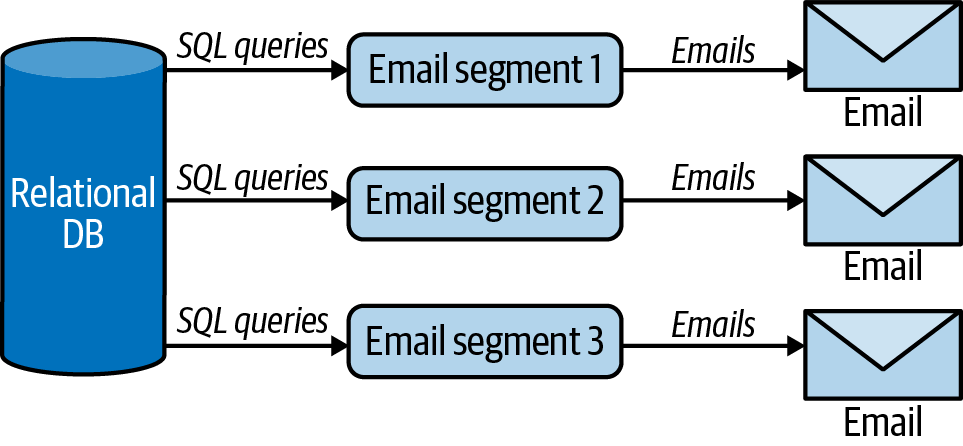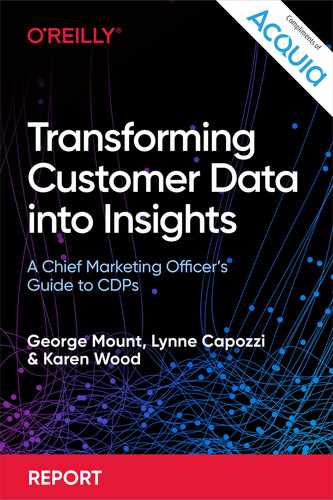Chapter 2. Classic Data Problems, Classic Marketing Tools
In Chapter 1, you learned about how organizations of various sizes and industries benefited by adopting a more personalized, customer-centric approach to marketing. Later chapters will address the technological and cultural forces needed to make such a shift.
This chapter serves as a primer on marketing approaches that have preceded CDPs, most of which have used technology to learn about and respond to individual customers. You will see that these systems have evolved from offering static, one-way customer communication to continuously personalized and customer-informed ones.
Mass and Direct Response Marketing
Marketers adopted a variety of media to communicate with customers in the 20th century, starting with mass marketing and moving to more personalized direct response:
- Mass marketing
-
For the majority of the 20th century, the predominant marketing tool was mass media. The goal here was to publicize a brand to as many people as possible in a single event. Customers encountered these campaigns via television ads, billboards, and other media, where ads could be placed secondary to their main objectives.
Marketer Seth Godin coined this practice “interruption marketing” in his 1999 book Permission Marketing.1 The goal was to build brand loyalty and brand equity with these consumers. But, given the monolithic nature of mass media, it was difficult to determine individual customers’ behaviors and journeys.
While mass media is still with us today, it remains a primary lever of only the largest organizations. Moreover, by its nature the success of a mass media campaign is still difficult to track, despite the advances of individually targeted approaches—beginning with direct response.
- Direct response marketing
-
While mass marketing focuses on keeping a large base of customers broadly aware of and loyal to a brand, direct response marketing is designed to elicit immediate responses from individual customers. Direct response marketing can be seen as early as the 1870s, around the time that wildly popular catalogs from Sears, Roebuck and Company became mainstays of the American household (and, even in the case of Sears, selling entire new houses). Direct mail remains a force in marketing, valued at $58.41 billion in 2020. Other common direct response marketing approaches, both offline and online, include the following:
-
Internet marketing (online display ads, digital coupons, email marketing)
-
Mobile marketing (SMS, mobile banners)
-
Direct mail (fliers, catalogs, promotional letters)
-
Telemarketing
-
Direct response television
While marketers were already collecting and acting on customer data generated by direct response campaigns, digital media and particularly email greatly expanded that scope. The use of this new medium opened up what the next section will call database-driven marketing: a progression of tools used to help segment and target customers based on predefined relationships in the data.
-
Database-Driven Marketing
A cumbersome digital messaging system used primarily between academics as it matured in the 1970s, email became a staple of the new consumer internet by the 1990s. By this time, data storage had also graduated from punch cards to tape to disk and beyond.
Using highly structured and predefined rules, data collected from direct response campaigns was stored in a series of tables comprising rows and columns. Relationships between columns in these tables could then be defined to build a relational database. The data used to create these segments often consisted of so-called RFM or recency, frequency, monetary data; that is, a focus on transactions rather than a more holistic view of the customer’s behavior and preferences.
Figure 2-1 shows what a relational database to store donation information might look like. For example, the donor_id column in the donations table can be used to look up information about each respective donor due to its relation to the corresponding donor_id column in the donors table. A segmentation here might be created to, for example, target all patrons who have made an annual donation of at least $100 in the last three years.

Figure 2-1. Example of a relational database to track campaign performance
A new field of database marketing, coined by Robert Shaw and Merlin Stone in a 1988 book of the same name,2 emerged as an improved form of direct marketing given these advances in data storage. In particular, database marketers used structured query language (SQL)—the traditional programming language used to interact with relational databases—to generate customer lists. Using conditional and other rule-based criteria, the database marketer could create segments of customers and then send targeted emails to those segments.
Figure 2-2 shows how database marketing works.

Figure 2-2. How database marketing works to email segmented customers
Some of the technologies to come out of this era of marketing include the data warehouse, the customer relationship management system, and the data management platform:
- Data warehouses
-
The problem with segmenting customers from an individual database is that it offers only a single engagement channel to analyze: in the case of database marketing, email. In Chapter 3, you will learn about the explosion of customer engagement channels in the 21st century. But even in the 20th, customers were engaging with brands with far more than just email, including some of the media highlighted in the previous section.
In contrast to a relational database, a data warehouse can store and merge data from multiple sources. Like the relational database, it depends on predefined structures and relations between sources to do so. The data warehouse offers a relatively more comprehensive view of the customer than a single marketing database.
Early data warehouses were still primarily designed for and implemented by technical users and not the marketing team itself. Over time, some data warehouse tools such as MicroStrategy and, later, Snowflake have come to include more user-friendly features for data analysis, such as point-and-click dashboard and report-building. That said, the data warehouse as a general architecture was not developed as an explicitly marketing-driven tool.
Eventually, however, some dedicated tools for marketing automation began to streamline the distribution and measurement of campaign-related tasks and workflows. This became a specialty of customer relationship management software.
- Customer relationship management (CRM)
-
Database marketing is designed foremost to send specific email campaigns to segmented customers. On the other hand, a CRM system is meant to manage customer relationships through the entire life cycle. Salesforce defines a CRM as “a technology for managing all your company’s relationships and interactions with customers and potential customers…A CRM system helps companies stay connected to customers, streamline processes, and improve profitability.”
- Data management platform (DMP)
-
As customers began to spend more time online, marketers sought to target them with segmented offers and messages just as they had been able to do with email. The DMP was created to do this and achieved its goal largely through browser cookies. When consumers accept cookies on their browser, information about their behavior across the web is collected by the DMP.
These user profiles are considered “pseudonymous”—not instantly recognizable, but not systemically anonymized either. An anonymous view of an individual customer is enriched with external third-party data as that customer’s behavior is made visible through their browser cookie. These profiles are leveraged to find similar profiles on third-party advertising sites. Using these pseudonymous personas, the DMP can segment and target to presumed customers.
Facebook is a well-known example of a DMP: data is collected about users, and advertisers can use it to target Facebook users with ads.
The Benefits and Disadvantages of Database-Driven Marketing
Largely starting with email, database-driven marketing opened new doors for customer engagement. At the same time, challenges remained in providing truly customer-centric marketing:
- Opt in
-
In theory, the premise of email marketing is that consumers provide their email willingly in exchange for some perceived value. Regulations such as CAN-SPAM in the US and GDPR in Europe ensures that consumers are able to unsubscribe and opt out of emails. This means that the premise of email should be on permission, rather than interruption, marketing.
- Mass personalization
-
Through segmentation of databases and a CRM-charted customer path, organizations began to be able to provide unique offers, messages, and content to individuals. This personalization is determined by rules-based and marketer-driven criteria.
- Siloed data, inconsistent experiences
-
While data warehouses and CRMs help to unify disparate sources of data, none do so with individual customer identity and experience in mind. For example, a customer may purchase an item at the store, only to be emailed with an offer or message to buy the same item a few days later. Customers expect that an organization can act from a single repository of data and knowledge about them, but this isn’t the case when customer data remains siloed across systems.
- Slow and cumbersome data usage
-
To maintain segments and track customer journeys, the marketing systems discussed so far rely on predefined data relationships and backward-facing data. Customers may benefit from some personalization, but this is based on aggregates of similar individuals’ past behavior rather than real-time tracking of current wants and needs.
Since the early days of direct response, marketers have constructed a whole new playbook for crafting unique customer experiences, so different than traditional mass media. That said, currently popular approaches to database-driven marketing haven’t gone far enough in putting the customer experience first. In Chapter 3, you will learn about additional challenges that marketers have faced more recently in doing so and the potential that customer data platforms (CDPs) have in overcoming these struggles.
